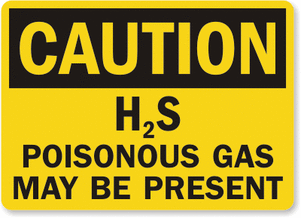| Running Out of Gas | The Dangers of Hydrogen Sulfide (H2S) |
As one of the leading causes of workplace gas inhalation deaths, hydrogen sulfide is a danger that must be taken seriously. Hydrogen sulfide gas is colorless, flammable and has a “rotten egg” smell. Depending on the level and duration of H2S exposure, the health effects will vary. Symptoms can include mild irritation, memory problems, headaches, fatigue, difficulty breathing, cardiovascular problems, coma, death and many others. The effects of exposure can be both short- and long-term.
Hydrogen Sulfide is also an explosive gas, which can cause life-threatening situations if not handled properly. The gas can travel to

ignition sources and flashback. When H2S burns, it produces additional toxic vapors and gases.
Many workers are at risk for hydrogen sulfide exposure, as it is used in many industrial processes, and also is produced naturally from decaying organic matter. Increased risk is seen in confined spaces, windless spaces, or low-lying areas, where hydrogen sulfide can build up to dangerous levels. Manholes, sewer lines, basements, and underground electrical vaults are common areas where the gas can collect. Marshy landscapes and areas near manure or other organic materials are also at higher risk for H2S gas accumulation.
Before entering areas where hydrogen sulfide may be present, the air must be tested by a qualified person. If H2S is present, the space must be ventilated to remove the gas. If it can’t be removed, many precautions must be taken prior to entering the area, such as using proper respiratory protection and other needed personal protective equipment.
OSHA has standards for general industry, construction and shipyards that must be followed for hydrogen sulfide exposure. For more information on hydrogen sulfide and an excellent H2S awareness course, please see our Online Hydrogen Sulfide Awareness training.



